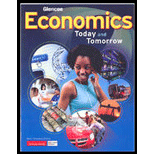
To evaluate the working process of money and the banking system in the United States, by using the following terms money, barter, commodity money, representative money, fiat money, legal tender, overdraft checking, electronic funds transfer, automated teller machine, checking account, debit card, near moneys.
Explanation of Solution
Money; free trade is the foundation of the market economy. Most Americans think money is bills, coins, and checks. Historically, money was often shells, gold, or sheep. Today, all United States currency is fiat money, implying that its face value exists by government fiat or order. It is declared a legal tender in this sense. The US monetary system is a decimal method with a dollar equivalent to one hundred cents. One dollar is written for a pound or a pound, and one cent for a dollar.
Barter; in the 1930s, bartering became widespread due to a shortage of capital at the time of Great Depression. Used to procure milk, as well as numerous other facilities. It was done by organizations or by individuals acting in a similar way to the banks. If any items are sold, the credit is given by owner and the buyer's account is debited.
Commodity money; it is a medium of Exchanges such as cattle or gems which, apart from their value as currency, have value as a commodity or good. Chicago Trade Board, Chicago Mercantile Exchange, the New York Trade Board and the New York Mercantile Exchange are the main exchanges of goods in the US.
Representative money; it is the money that is backed by an item of value such as gold or silver. The greatest benefit for representative currency was that it was not influenced by inflation; governments were only able to print ample currency for the gold amount they retained in their vaults. In 1971, the U.S. cut its ties to the gold standard, turning its currency into fiat money.
Fiat money; is a legally tender which the value of which is guaranteed by the State issuing the tender. The US dollar is a fiat currency, as is the euro and many other big world currencies. For example, for much of the late ninetieth and early twentieth century’s, the United States followed a gold standard.
Legal tender; under U.S. federal law, when creditor to a tendered. Dollars in the U.S.is a legal and valid payment of offer for a prior debt. In comparison, federal law does need a seller to accept federal money or coins as payment for products or services exchanged at the same time.
Checking overdraft; US bank overdraft Daily Maximum, the average daily overdraft fee is four times a day, and the annual overdraft rate is $144 a day. If account balance was negative before the gap of eighth days of the year, on the eighth day of the year that was paid $36.
Transfer of electronic funds; is a form of direct transfer of Money from Bank account to Bank account, without any physical money changing hands. EFT therefore applies to any transfer of funds facilitated by an electronic terminal such as credit card, ATM, Fedwire and point-of - sale (POS) transactions.
First ATM opens up for service. On 2 September 1969, at Chemical Bank in the center of Rockville, New York, America's first automated teller machine made selling cash to customers.
A checking account is a savings account which enables the holder to make deposits and withdrawals with a bank or other finance organization. Checking accounts are extremely liquid, allowing multiple deposits and withdrawals as against to less amount of savings or investment accounts.
Debit card; they are usually for checking of account, and keeping these accounts may require a monthly fee of about $10 to $15. These fees are excluded for many banks if holding a certain amount monthly in minimum balance.
Near to money; foreign currencies often used such as dollar, euro, British pound, or Japanese yen.
Introduction: Also a primary feature of US banking industry was the extremely high number of very small banks. Another benefit was that U.S. banks had more specific authority to provide stock, insurance, and real estate-related financial services than foreign banks in other countries had done.
Want to see more full solutions like this?
Chapter 14 Solutions
Economics Today and Tomorrow, Student Edition
Additional Business Textbook Solutions
Principles of Accounting Volume 1
Managerial Accounting (4th Edition)
Principles of Accounting Volume 2
Cost Accounting (15th Edition)
Horngren's Cost Accounting: A Managerial Emphasis (16th Edition)
Principles of Management

 Principles of Economics (12th Edition)EconomicsISBN:9780134078779Author:Karl E. Case, Ray C. Fair, Sharon E. OsterPublisher:PEARSON
Principles of Economics (12th Edition)EconomicsISBN:9780134078779Author:Karl E. Case, Ray C. Fair, Sharon E. OsterPublisher:PEARSON Engineering Economy (17th Edition)EconomicsISBN:9780134870069Author:William G. Sullivan, Elin M. Wicks, C. Patrick KoellingPublisher:PEARSON
Engineering Economy (17th Edition)EconomicsISBN:9780134870069Author:William G. Sullivan, Elin M. Wicks, C. Patrick KoellingPublisher:PEARSON Principles of Economics (MindTap Course List)EconomicsISBN:9781305585126Author:N. Gregory MankiwPublisher:Cengage Learning
Principles of Economics (MindTap Course List)EconomicsISBN:9781305585126Author:N. Gregory MankiwPublisher:Cengage Learning Managerial Economics: A Problem Solving ApproachEconomicsISBN:9781337106665Author:Luke M. Froeb, Brian T. McCann, Michael R. Ward, Mike ShorPublisher:Cengage Learning
Managerial Economics: A Problem Solving ApproachEconomicsISBN:9781337106665Author:Luke M. Froeb, Brian T. McCann, Michael R. Ward, Mike ShorPublisher:Cengage Learning Managerial Economics & Business Strategy (Mcgraw-...EconomicsISBN:9781259290619Author:Michael Baye, Jeff PrincePublisher:McGraw-Hill Education
Managerial Economics & Business Strategy (Mcgraw-...EconomicsISBN:9781259290619Author:Michael Baye, Jeff PrincePublisher:McGraw-Hill Education





